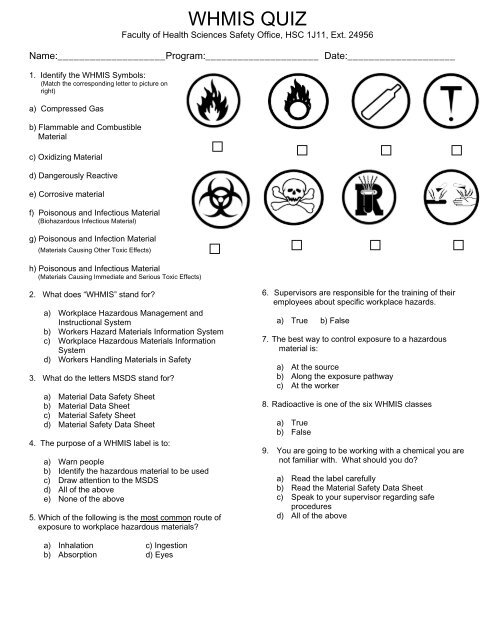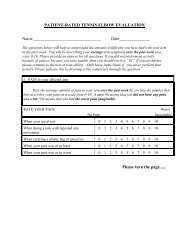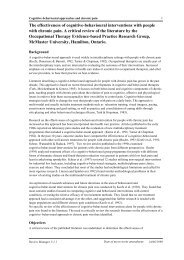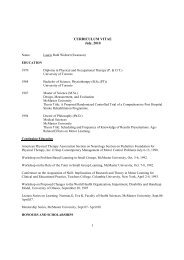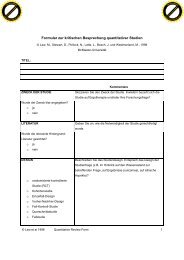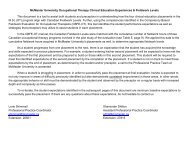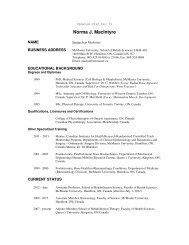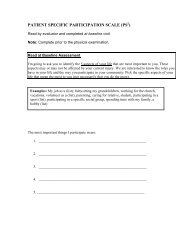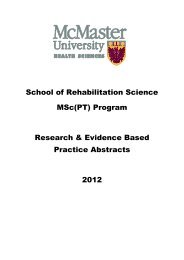WHMIS QUIZ
WHMIS QUIZ
WHMIS QUIZ
- No tags were found...
Create successful ePaper yourself
Turn your PDF publications into a flip-book with our unique Google optimized e-Paper software.
<strong>WHMIS</strong> <strong>QUIZ</strong>Faculty of Health Sciences Safety Office, HSC 1J11, Ext. 24956Name:____________________Program:_____________________ Date:____________________1. Identify the <strong>WHMIS</strong> Symbols:(Match the corresponding letter to picture onright)a) Compressed Gasb) Flammable and CombustibleMaterialc) Oxidizing Materiald) Dangerously Reactivee) Corrosive materialf) Poisonous and Infectious Material(Biohazardous Infectious Material)g) Poisonous and Infection Material(Materials Causing Other Toxic Effects)h) Poisonous and Infectious Material(Materials Causing Immediate and Serious Toxic Effects)2. What does “<strong>WHMIS</strong>” stand for?a) Workplace Hazardous Management andInstructional Systemb) Workers Hazard Materials Information Systemc) Workplace Hazardous Materials InformationSystemd) Workers Handling Materials in Safety3. What do the letters MSDS stand for?a) Material Data Safety Sheetb) Material Data Sheetc) Material Safety Sheetd) Material Safety Data Sheet4. The purpose of a <strong>WHMIS</strong> label is to:a) Warn peopleb) Identify the hazardous material to be usedc) Draw attention to the MSDSd) All of the abovee) None of the above5. Which of the following is the most common route ofexposure to workplace hazardous materials?6. Supervisors are responsible for the training of theiremployees about specific workplace hazards.a) True b) False7. The best way to control exposure to a hazardousmaterial is:a) At the sourceb) Along the exposure pathwayc) At the worker8. Radioactive is one of the six <strong>WHMIS</strong> classesa) Trueb) False9. You are going to be working with a chemical you arenot familiar with. What should you do?a) Read the label carefullyb) Read the Material Safety Data Sheetc) Speak to your supervisor regarding safeproceduresd) All of the abovea) Inhalation c) Ingestionb) Absorption d) Eyes
Using the attached MSDS answer the followingquestions.10. Name the hazard class isopropyl alcohol inbelongs in.________________________________________13. Create a workplace label for isopropyl alcohol.111. What would you do if you were splashed in theeye with isopropyl alcohol?____________________________________________________________________________________________________________________________________________________________________________________2.3.Material Safety Data SheetSection 1 IdentificationProduct Number: C1950IsopropylProduct Name:Alcohol 70% v/vTrade/ChemicalSynonymsFormula:N/ARTECS:C.A.SSee BelowSection 2 Component MixtureSara313Health: 2Flammability 3Reactivity 0Hazard Rating:Least Slight Moderate High Extreme0 1 2 3 4NA = Not Applicable NE = NotEstablishedComponent CAS Number % Dim Exposure Limits:Water,Deionized ASTMType IIIsopropylAlcohol (2-propanol)CAS# 7732-18-5 Balance v/vCAS# 67-63-0 70% V/VNoneEstablishedOSHA TWA 400ppm, STEL 500ppmSection 3 Hazard Identification (Also see section 11)Keep away from heat and ignition sources. Harmful if swallowed. Avoid breathingvapors. Use with adequate ventilation. Avoid contact with eyes, skin, and clothes.Wash thoroughly after handling. Keep container closed.Section 4 First Aid MeasuresKeep away from heat and ignition sources. Harmful if swallowed. Avoid breathingvapors. Use with adequate ventilation. Avoid contact with eyes, skin, and clothes.Wash thoroughly after handling. Keep container closed.FIRST AID: SKIN: Wash exposed area with soap and water. If irritation persists,seek medical attention.EYES: Wash eyes with plenty of water for at least 15 minutes, lifting lidsoccasionally. Seek Medical Aid. INHALATION: Remove to fresh air. If not breathing,give artificial respiration. If breathing is difficult, give oxygenINGESTION: If swallowed, induce vomiting immediately after giving two glasses ofwater. Never give anything by mouth to an unconscious person.Section 5 Fire Fighting MeasuresSection 6 Accidental Release MeasuresEliminate Ignition Sources. Absorb with vermiculite or other inert material. Place incontainer.Section 7 Handling and StorageStore in a cool dry well ventilated area. Keep away from heat and flame. Do not getin eyes, on skin, or on clothing.Section 8 Exposure Controls & Personal ProtectionRespiratory Protection:None requiredMechanical:Ventilation: Local Exhaust:HandProtection:EyeProtection:Gloves to prevent skin exposure aslatex or vinylSplash GogglesOther Protective Equipment: Wear appropriate clothing to prevent skin exposureSection 9 Physical and Chemical PropertiesMelting Point:Boiling Point:Vapor Pressure:Vapor Density:Solubility inWater:Appearance andOdor:Flash Point:Information notavailableInformation notavailableInformation notavailableInformation notavailableSolubleClear liquid, mildalcohol odorInformation notavailableSection 10 Stability and Reactivity InformationSpecific Gravity ~0.9Percent Volatile byVolume:Evaporation Rate:EvaporationStandard:Auto ignitionTemperature:Lower Flamm. Limitin Air:Upper Flamm. Limitin Air:>99Information notavailableNot applicableNot applicableNot applicableConditions to Avoid: Avoid contact with heat, sparks, flames, orStability: Stableother sources of ignition.Materials to Avoid:Strong oxidizing agents, metals, bases, amines.Hazardous Decomposition Products:Oxides of CarbonHazardous Polymerization:Will Not OccurCondition to Avoid:None knownFire ExtinguisherType:Fire/ExplosionHazards:Fire FightingProcedure:Alcohol Resistant Foam, Carbon DioxideMaterial will burn in a fire.Wear self-contained breathing apparatus and protectiveclothing to prevent contact with skin and clothing.Section 11 Additional InformationConditions aggravated/Target organs: Persons with preexisting skin, eye,respiratory disorders may be more susceptible. Acute: Irritation to skin, eyes, lungs,mucous membranes and GI tract, nausea, narcosis, drowsiness, dizziness. Chronic:Dermatitis, eye damage.DOT Classification: Isopropanol Solution, 3, UN1219, PG IIDOT regulations may change from time to time. Please consult the most recentversion of the relevant regulations.Revision No:0.1 Date Entered: 9/1/2009 Approved by: WPF


